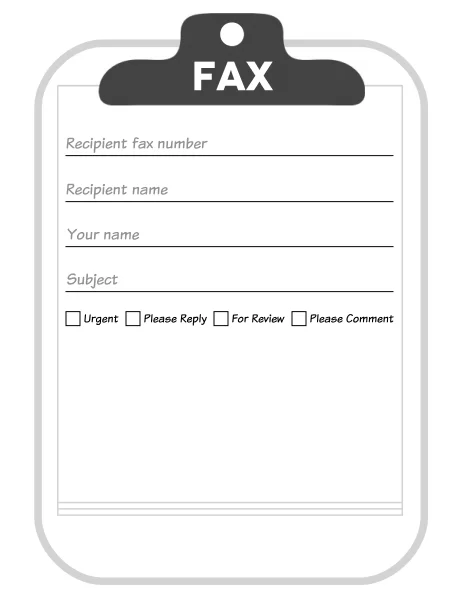In today’s digital landscape, privacy breaches can pose significant risks. Healthcare providers must secure their sensitive patient information to avoid unnecessary data leakage. When using HIPAA fax templates, you can prevent unauthorized access to your patient’s confidential and sensitive data.
Table of Contents

Importance of HIPAA-Compliant Fax Templates
HIPAA-compliant fax templates are designed to address the specific requirements outlined by HIPAA. These templates offer a standardized format for transmitting patient information securely, reducing the chances of errors, unauthorized access, and data breaches.
Ensuring patient privacy and data security
Patient information is highly susceptible to data breaches and must be protected at all costs. HIPAA-compliant fax templates provide a secure framework for transmitting this information, reducing the risk of unauthorized access, interception, or data breaches.
Reducing the risk of HIPAA violations
By adhering to the specific requirements outlined by HIPAA, these templates ensure that patient information is transmitted securely. Standardized formats can help minimize the chances of errors or omissions that could lead to non-compliance.
Encryption protocols embedded within the templates add an extra layer of security, preventing unauthorized access to confidential documents. This will help healthcare providers secure and maintain the integrity of confidential patient data.

3 Key Components of HIPAA-Compliant Fax Templates
HIPAA-compliant fax templates play a vital role in the healthcare industry by ensuring compliance with regulations and protecting patient privacy.
Let’s explore the three key components that make these templates an essential resource for healthcare providers.
1. Standardized format
HIPAA-compliant fax templates establish a uniform structure for transmitting patient information. They include dedicated fields for essential details such as patient demographics, medical history, and treatment plans. This standardization streamlines the faxing process, ensuring all necessary information is communicated consistently and accurately.
2. Encryption and security measures
These security measures protect sensitive information from unauthorized access and ensure that only authorized individuals can view and retrieve the faxed documents. Encryption adds an extra layer of security, giving healthcare providers peace of mind.
3. Confidentiality notices and disclaimers
HIPAA-compliant fax templates include confidentiality notices and disclaimers that alert recipients to the sensitive nature of the included information. These notices emphasize the importance of safeguarding patient privacy and remind recipients to handle the received faxes with the utmost care.
Inclusion of Necessary Patient Information
You can secure all necessary patient information in a standardized manner using HIPAA-compliant fax templates. There are also dedicated fields for vital details like patient demographics, medical history, and treatment plans, making it easy for healthcare providers to input and transmit accurate information.
By using these templates, you can include all essential data without overlooking critical elements. This streamlined approach saves time and reduces the chances of errors or omissions. In turn, the recipient will get a comprehensive overview of the patient’s health information.
Proper Handling of Protected Health Information (PHI)
Protect your patient’s sensitive data by properly handling Protected Health Information (PHI). By maintaining a vigilant approach to managing PHI, healthcare providers can protect patient privacy and maintain compliance with HIPAA regulations.
Limit access to authorized personnel
You can achieve this through strict authentication measures, such as unique user IDs, passwords, and role-based access controls. Moreover, healthcare providers must implement physical safeguards, such as locked cabinets and restricted access areas, to prevent unauthorized individuals from physically accessing PHI.
Adhering to proper handling procedures includes maintaining an audit trail to track who accessed or made changes to PHI and conducting regular security training for staff members to promote awareness and reinforce compliance.
Utilize encrypted communication channels
When sharing PHI electronically, it’s vital to utilize encrypted communication channels, such as secure email or HIPAA-compliant fax systems. Encryption converts sensitive information into a coded format, making it unreadable to unauthorized individuals during transmission.
Proper handling also entails avoiding the use of unsecured or public Wi-Fi networks, as these can pose significant risks to the confidentiality of PHI. Furthermore, healthcare providers should implement policies and procedures for proper disposal of PHI. You must ensure that paper documents are shredded, and digital files are permanently deleted or must be rendered unreadable.
Confidentiality Notices and Disclaimers
Confidentiality notices and disclaimers are an important aspect of using HIPAA-compliant fax templates. These notices serve as gentle reminders to the recipients about the sensitive nature of the transmitted information. They emphasize the need to handle the received faxes with utmost care and maintain patient privacy and confidentiality.
By including confidentiality notices and disclaimers in the fax templates, healthcare providers create an additional layer of awareness regarding the importance of protecting patient data. These notices contribute to building a culture of data security within healthcare organizations, ensuring that everyone involved understands their responsibilities in safeguarding confidential information.

Implementing HIPAA-Compliant Fax Templates in Your Healthcare Organization
Here’s how to successfully implement HIPAA-compliant fax templates in your healthcare organization:
1. Assess your current faxing workflow
Evaluate the security measures in place, such as encryption protocols, access controls, and handling of faxed documents. Optimized fax transmissions are essential to enhance overall communication between patients and healthcare providers.
2. Explore different fax solutions
Compare options, read reviews, and choose a solution that best aligns with your organization’s needs and budget. Choosing the right fax template can save you time, money, and resources. Without investing in secure and cost-efficient fax solutions, your healthcare organization is bound to put your patient’s data at risk.
3. Customize HIPAA-Compliant fax templates
Once you’ve selected a fax solution, ensure that the templates include the necessary fields for patient information, confidentiality notices, disclaimers, and any other elements relevant to your organization’s workflows.
4. Conduct comprehensive staff training
Educate your staff on the importance of protecting patient privacy and handling sensitive information. Make sure they understand how to properly fill in the template fields, use encryption features, and manage received faxes securely.
5. Develop clear policies and procedures
These guidelines should cover aspects such as who can send and receive faxes, how to handle faxed documents, when to use encryption, and how to report any potential breaches or incidents.
6. Perform regular audits and reviews
Perform periodic assessments to ensure proper implementation of the templates within your organization. Stay updated on changes to HIPAA regulations and adapt your templates accordingly to maintain compliance.
Effectively Manage Patient Data Using HIPAA-Compliant Fax Templates
HIPAA-compliant fax solutions and templates provide a wide range of benefits for patients and healthcare organizations. With a reliable fax template, healthcare providers can transmit patient information with confidence, knowing that it adheres to the strict privacy and security standards set by HIPAA.
You can customize the templates and tailor them to your specific needs. More importantly, you can prevent unauthorized disclosures that could potentially jeopardize your patient’s safe







